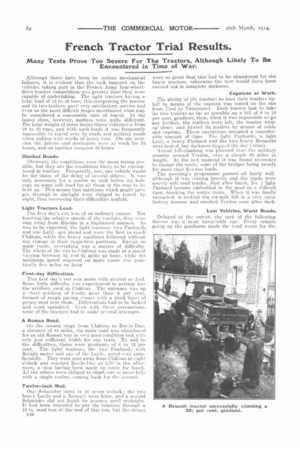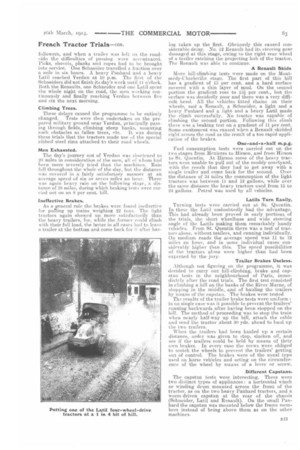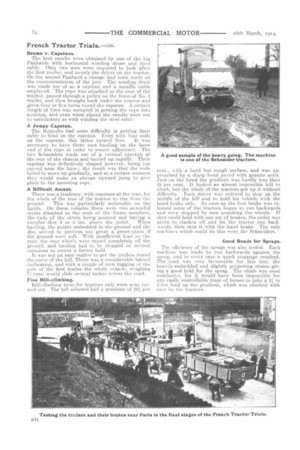French Tractor Trial Results.
Page 6

Page 7

Page 8

If you've noticed an error in this article please click here to report it so we can fix it.
Many Tests Prove Too Severe For The Tractors, Although Likely To Be Encountered in Time of Wax.
Although there have been no serious mechanical failures, it is evident that the task imposed on the vehicles taking part in the French Army four-wheeldrive tractor competition was greater than they were capable of undertaking. The, light tractors having a total load of 13 to 16 tom) this comprising the tractor and its two trailers, gave very satisfactory service and even on the most difficult. stages maintained what may be considered a reasonable rate of travel. In the heavy class, however, matters. were quite different. The total -weight of these trains (three vehicles) is from 22 to 23 tons, and with such loads it was frequently impossible to travel over by roads and military roads when sodden with weeks of heavy rain. On one occasion the drivers and mechanics were at work for 24 hours, and on another occasion 36 hours.
Blocked Roads.
Obviously the conditions mete the most trying possible, but they are the conditions likely to be encountered in warfare_ Frequently, too, one vehicle would be the cause of the delay of several others.. Tt was only necessary for a trailer to sink below its hubcaps on some soft road for all those in the rear to be held up. This meant that machines which might have got through in daylight were obliged to travel by night, thus increasing their difficulties tenfold.
Light Tractors Lead.
The first day's run was of an ordinary nature. Not knowingthe relative speeds of the tractors, they were sent away from Rheims in a haphazard mariner. As was to be expected, the light tractorstwo Pan!undo and one Latil—got ahead and were the first to reach Chalons, while the heavy machines followed without any change in their respective positions. Except on main roads, overtakiins was a matter of difficulty. The whole of the run to Chalons was made at a speed varying between 31 arid 6i miles an hour, w bile the minimum speed required on main roads was practically five miles an hour.
First-day Difficulties.
This first day's run w as made with alcohol as fuel. Some little difficulty was experienced in getting into the artillery yard at Chalons. The entrance was up a short gradient of hardly more than 6 per cent. formed of rough paving stones with a thick layer of greasy mud over them. Differentials had to be locked and sand sprinkled. Even with these precautions, some of the tractors had to make several attempts.
A Roman Road.
On the second stage from Chalons to Bar-le-Due, a distance of 43 miles, the main road was abandoned. for an old Roman way in very poor condition and with only just. sufficientwidth for one train. To add to the difficulties, there were gradients of 8 to l2 per cent. The light tractors, the two Panhards; with Knight motor and one of the Latils„ acted very satisfacto'rily. They were sent away from Chalons at eight o'clock and reached Ear-le-Due at 3.30 in the afternoon, a stop having been made en route for lunch. All the others were obliged to climb one or more hills with a single trailer, coming back for the second.
Twelve-inch Mud.
One Schneider came in at seven o'clock ; the two heavy Latils and a Renault were later, and a. second Schneider did not finish its journey until midnight. It had been intended to put the tractors throughsr 12 in. mud test at the end of this run, but the delays B10 were so great that this had to be abandoned for the heavy tractors, otherwise the test would have been carried out in complete darkness.
Capstans at Work.
The ability of the tractors to haul their trailers uphill by means of the capstan was tested on. the run from .roul to Thiaucourt. Each tractor had to take its two trailers as far as possible up a. hill of 9 to 10 per cent. gradient, then, when it was impossible to go any further, the trailers were left, the tractor went up alone, and hauled its trailers by means of cable and capstan. These operations occupied a considerable amount of time. The light Panhards, a light Latil, a heavy Panhard and the two heavy Renaults were tested, but darkness stopped the day's trials.
Actual hill-climbing was planned over the military country around Verdun, over a circuit 40 miles in length. At the last moment it was found necessaryto change the route, some of the bridges being unsafe for more than five-ton loads.
The morning's programme passed off fairly well although it was raining heavily and the roads were merely soft mud tracks. Just after lunch, No. 1 light Panhard became embedded in the mud on a difficult turn. blocking the entire route. When it was finally extracted, it tackled the six-mile bill in a very satisfactory manner and reached Verdun soon after dark.
Last Vehicles, Worst Roads.
Delayed at the outset, the task of the following drivers was a most unenviable one. Every vehicle going up the gradients made the road worse for the
followers, and when a trailer was left on the roadside the difficulties of passing were accentuated. Picks., shovels, planks and ropes had to be brought into service. One Schneider travelled a fraction over a mile in six hours. A heavy Panhard and a heavy Latil reached Verdun at 10 p.m. The first of the Schneiders did not finish its day's work until II o'clock. Both the Renaults, one Schneider and one Latil spent the whole night on the road, the men working continuouslyand finally reaching Verdun between five and six the next morning.
Climbing Trees.
These delays caused the programme to be entirely changed. Tests were then undertaken on the prepared military ground near Verdun, -principally passing through fields, climbing steep banks, mounting
aueli obstacles as fallen trees, etc. It was during these trials that the tractors made use of the special rihbed steel rims attached to their road wheels.
Men Exhausted.
The day's journey out of Verdun was shortened to 29 miles in consideration of the men, all of N‘ horn had been more severely tried than the machines. Rain fell throughout the whole of the day, but the distance was covered in a fairly satisfactory manner at an average speed of six or seven miles an hoar. There was again heavy rain on the following stage, a distance of 35 miles, during which braking tests were carried out on an 8. per cent. hill.
Ineffective Brakes.
As a general rule the brakes were found ineffective for purling up trains weighing 22 tons, The light tractors again, showed up more satisfactorily than the heavy trailers, for, while the former could climb with their full load, the latter in all eases had to leave a trailer at the bottom and came back for it after hay ing taken up the first. Obviously this caused considerable delay. No. 12 Renault had its steering gear damaged at this stage, owing to the right rear wheel of a trailer catching the projecting hub of the tractor. The Renault was able to continue.
A Renault Skids More hill-climbing tests were made on the Montmedy-Charlevilie stage. The first part. of this hill has a gradient of 13 per cent. and a hard surface covered with a thin layer of mud. On the second portion the gradient rose to 134 per cent., but the surface was decidedly poor and there was a very difficult bend. All the vehicles fitted chains on their wheels, and a Renault, a Schneider, a light and a heavy Panhard and a light and a heavy Latil made the climb successfully. No tractor was capable of climbing the second portion. Following this climb there %V FUS a, braking test on a gradient of 11 per cent_ Sonic excitement was caused when a Renault skidded vight across the road as the result of a too rapid application of the brakes.
One-and-a-hall m.p.g.
Fuel consumption tests were carried out on the two stages. from Mezieres to Hirson, and from Hirson to St. Quentin. At Hirson some of the heavy tractors were unable to pull out of the nauddy courtyard, with the result that they had to get away with a single trailer and come back for the second. Over the distance of 34 miles the consumption of the light tractors was between 11 and 12 gallons, while over the same distance the heavy tractors used from 15 to 24 gallons, Petrol was used lay all vehicles.
Laths Turn Easily.
Turning tests. were carried out at St. Quentin. In these the Latil undoubtedly had the advantage. This had already been proved in early portions of the trials, the short wheelbase and wide steering angle of the Latils making them remarkably handy vehicles. From St.. Quentin there was a test of tractors alone, without trailers, and running individually. On medium roads the average speed was 11 to 12 miles an hour, and in some individual cases considerably higher than this. The speed possibilities of the tractors, alone were higher than had been expected bY the jury.
Trailer Brakes Useless.
Although not figuring on the programme, it was decided to carry out hill-climbing, brake and capstan tests in the neighbourhood of Paris, immediately after the road trials. The first test consisted in climbing 4 hill on the banks of the River Marne, of stopping in the middle, and of hauling the trailers by means of the capstan. The brakes were tested
The results of the trailer brake tests were uniform : in no single vase was. it possible to prevent the trailers' running backwards after having been stopped on the hill. The method of proceeding was to stop the train when nearly half-way up the hill, attach the cable and send the tractor about 30 yds. ahead to haul up the two trailers.
When the trailers had been hauled up a certain distance, order was given to stop, slacken off, and see if the trailers could be held by means of their own brakes. In every case the crews were obliged to scotch the wheels to prevent the trailers' getting out of control. The brakes were of the usual type used on horse vehicles and acting on the circumference of the wheel by means of a lever or screw.
Different Capstans.
The capstan tests were interesting. There were two distinct types of appliances : a horizontal winch or winding drum mounted across the front of the tractor, as on the two heavy Panhard tractors, and a worm driven capstan at the rear of the chassis (Schneider, Latil and Renault). On the small Panhard the capstan was mounted below the frame members instead of being above them as on the other machines.
Drums v. Capstans.
• The best results were obtained by one of the big Paniaards with horizontal winding drum and steel cable. Only two men were required to look after the first trailer, and merely the driver on the tractor. On the second Panhard-a, change had been made on the recommendation of the jury. The winding drum was made use of as a capstan and a manilla, cable employed. The rope was attached to the rear of the tractor, passed through a pulley on the front of No, 1 trailer, and then brought back under the tractor and given four or five turns round the capstan. A certain length of time was occupied in getting the rope into Pesition, and even when placed the results were not so satisfactory as with winding the steel cable.
A Jumpy Capstan.
The lienaulta had some difficulty in getting their cable to bind on the capstan. Even with four coils on the capstan, this latter turned free. It was necessary to have three men hauling on the loose end of the rope in order to secure adherence. The two Schneiders made use of a vertical capstan at the rear of the chassis and hauled up rapidly. Theit capstan was defectively shaped however, being too curved near the base ; the result was that the coils failed to move up gradually, and at a certain moment they would make an abrupt upward jump to give place to the incoming rope.
A Difficult Ascent.
There was a tendency, with capstans at the rear, for the whole of the rear of the tractor to rise from the ground. This was particularly noticeable on the Latils. On these vehicles there were two powerful struts attached to the ends of the frame members, the ends of the struts being pointed and having a circular disc 2 or 3 ins, above the point. When hauling, the points embedded in the ground and the disc served to prevent too great a penetration if the ground were soft. With insufficient load on the rear, the rear wheels were raised completely off the ground, and hauling had to be stopped on several occasions to secure a better hold.
It was not an easy matter to get the trailers round the curve of the hill. There was a considerable lateral inclination, and with a couple of men trigging at the pole of the first trailer the whole vehicle, weighing V, tons, would slide several inches across the road.
Fine Hill-climbing.
Hill-climbing tests for tractors only were next carried out. The hill selected had a gradient of 22!1 per
cent., with a hard but rough surface, and was approached by a sharp bend paved with granite setts. Just on the bend the gradient was hardly less than 25 per cent. It looked an almost impossible bill to climb, but the whole of the tractors got up it without difficulty. Each driver was ordered to stop on the middle of the hill and to hold his vehicle with the hand brake only. As soon as the foot brake was released some of the tractors began to run backwards and were stopped by men scotching the wheels. If they could hold with one set of brakes, the order was given to slacken off and let the tractor run backwards, then stop it with the hand brakeThe only inaehinrs which could do this were the Schneiders.
Good Roads for Sprags.
The efficiency of the sprags was also tested. Each machine was made to run backwards against the sprag, and in every case a quick stoppage resulted. The road was very favourable for this test, the heaviiy-embedded and slightly projecting stones giving a good hold for the sprag. The climb was most conclusive, for it would have been impossible for any easily controllable team of horses to take a 2 to 3-ton load up the gradient, which was climbed with ease by the tractors.




























